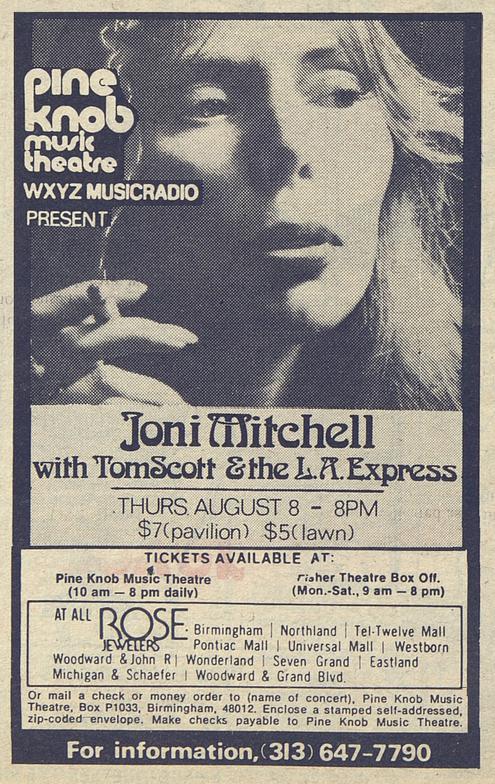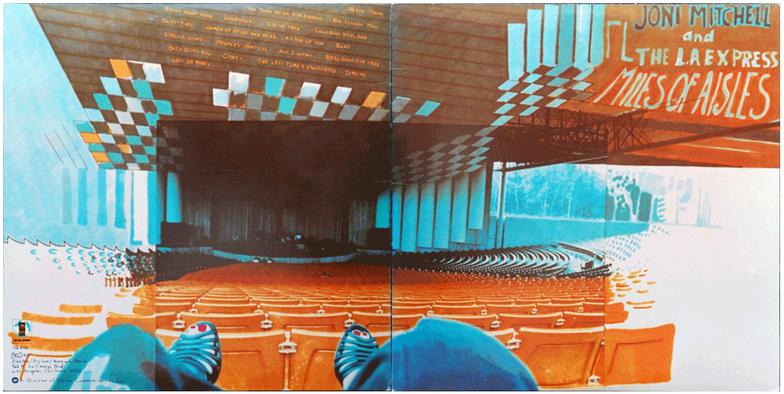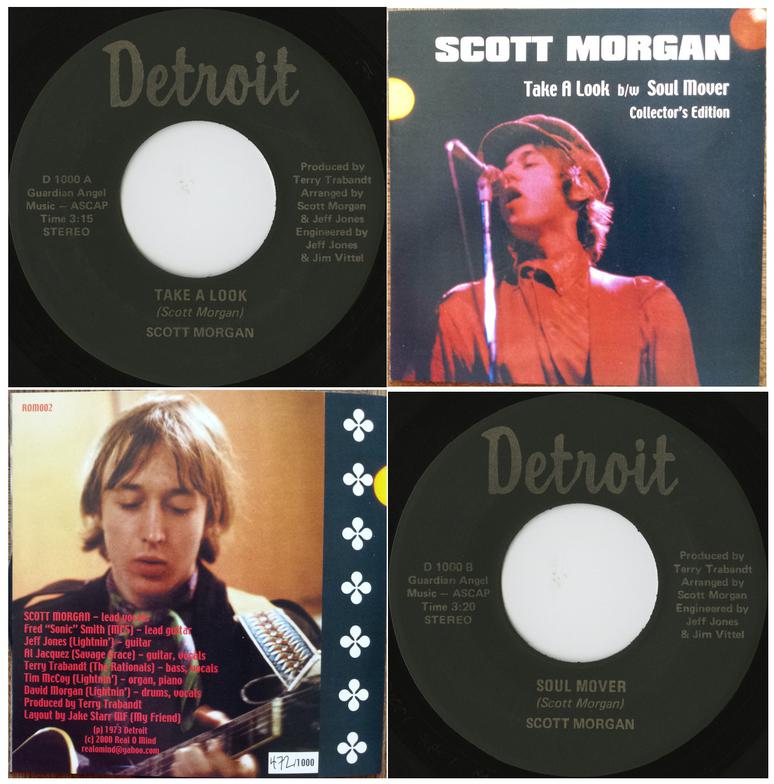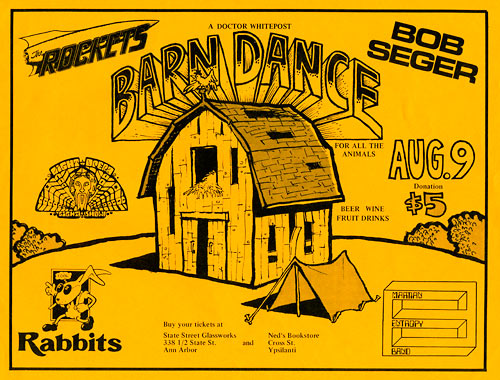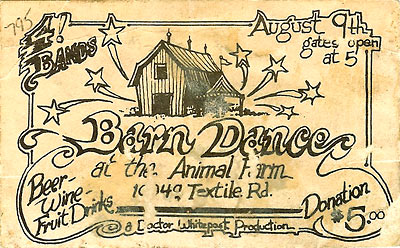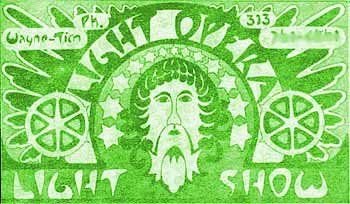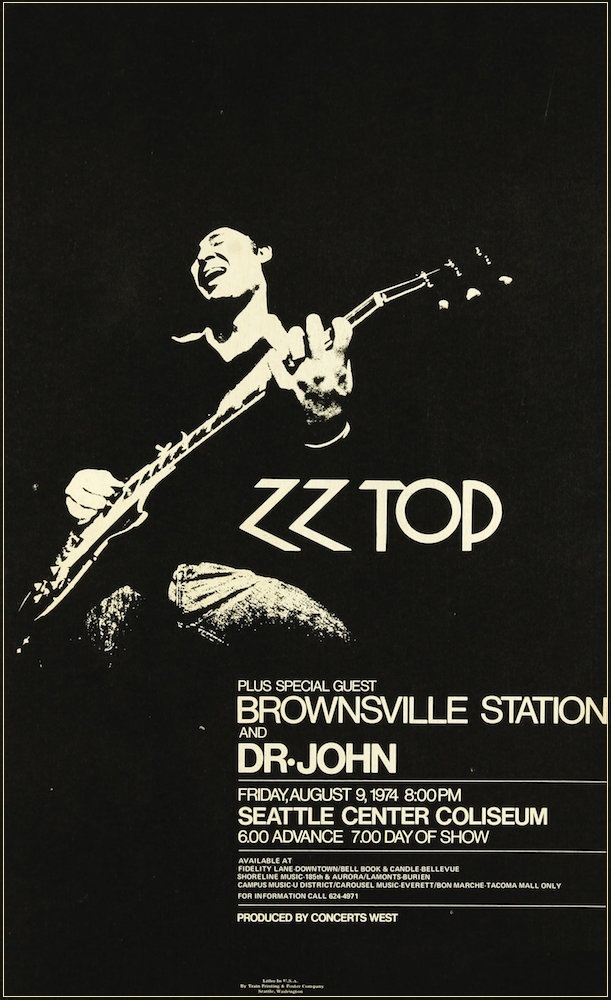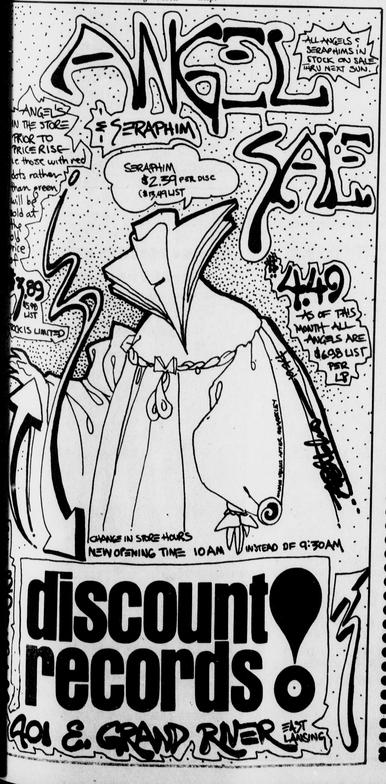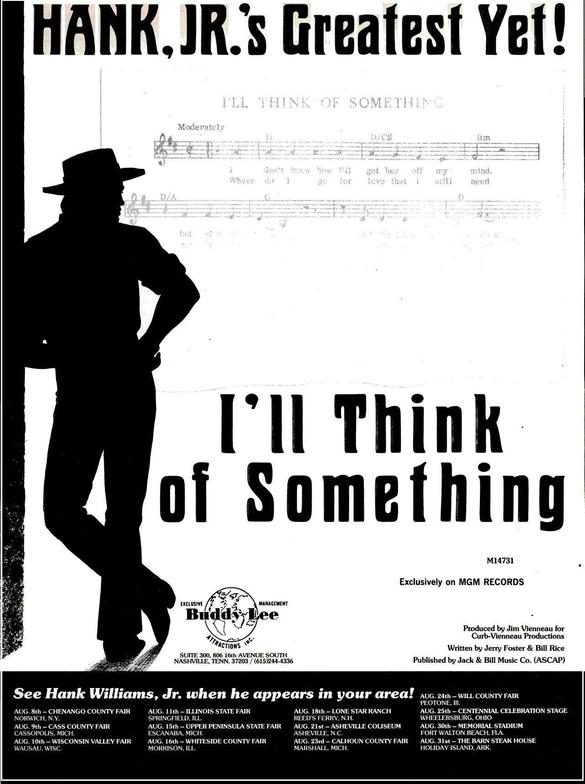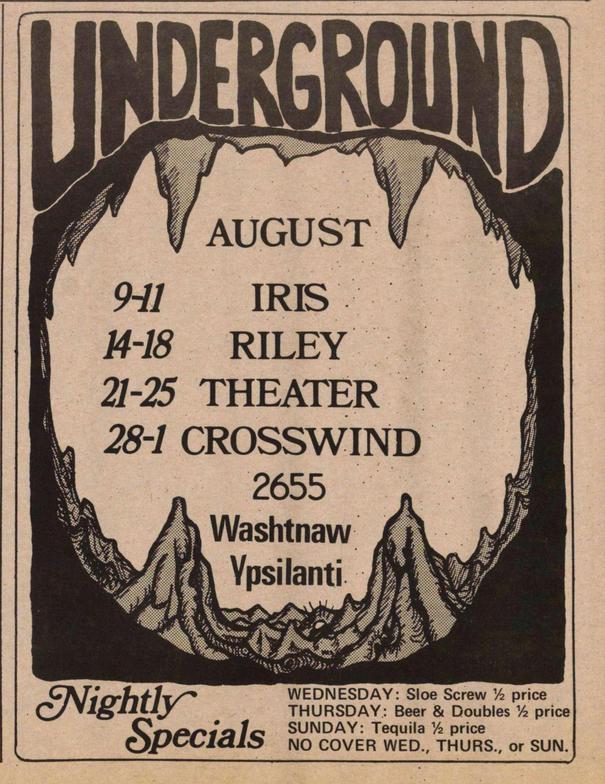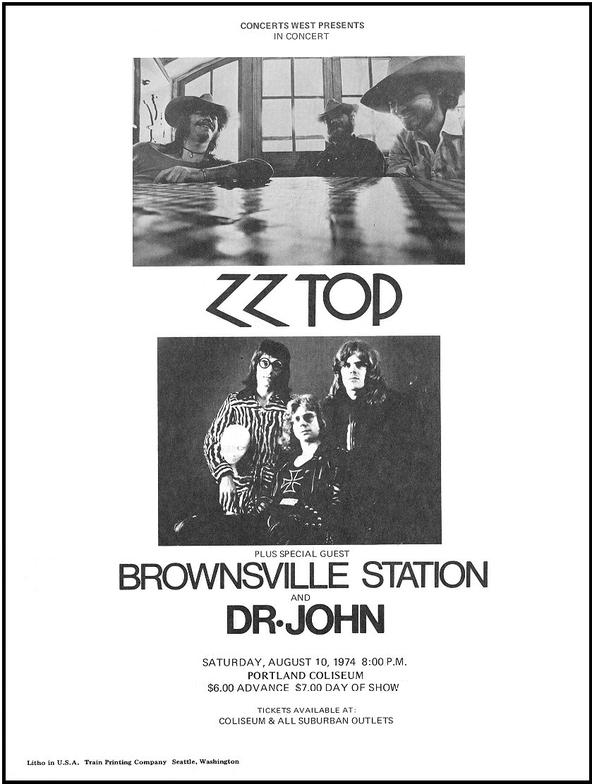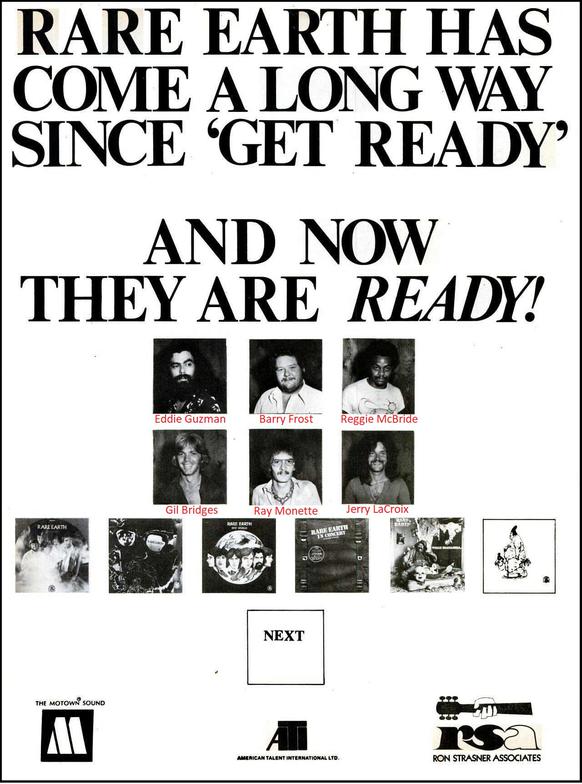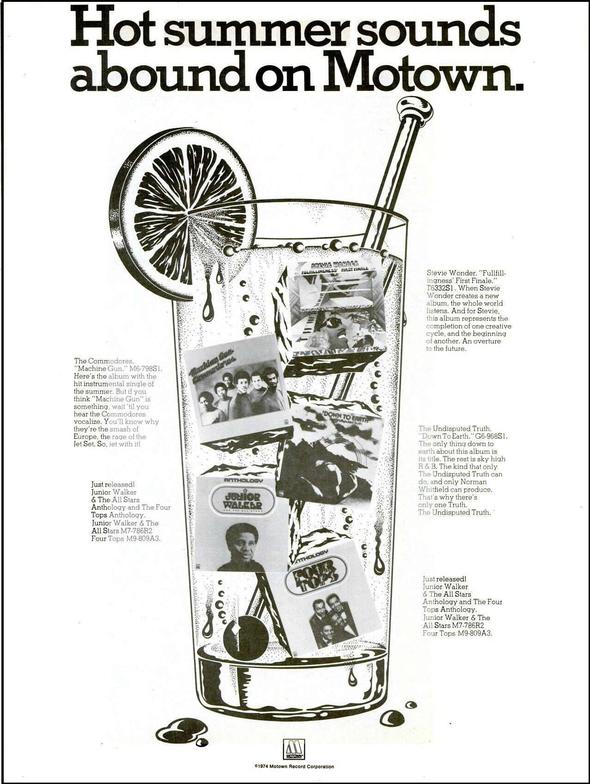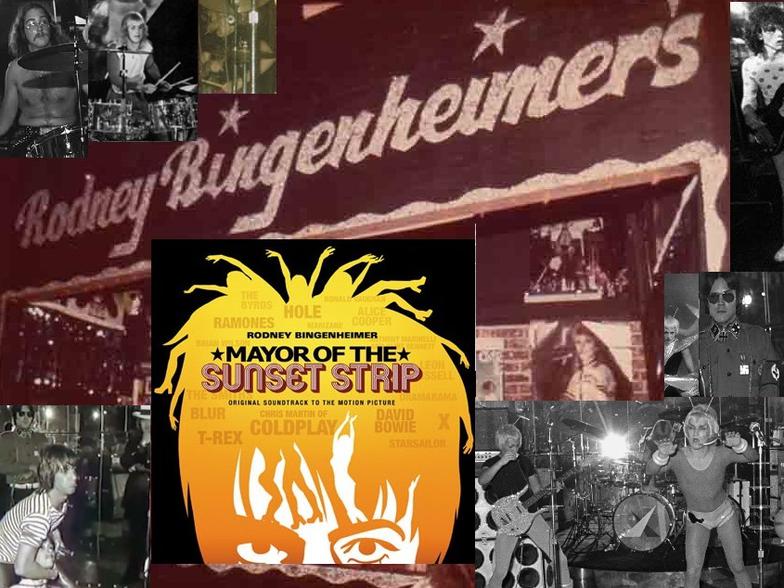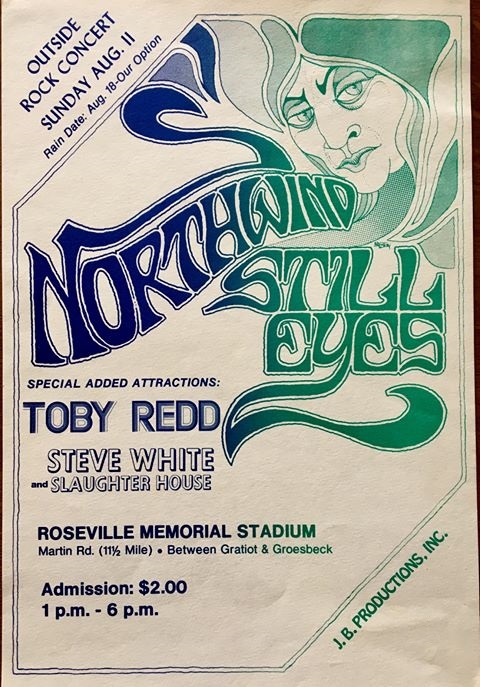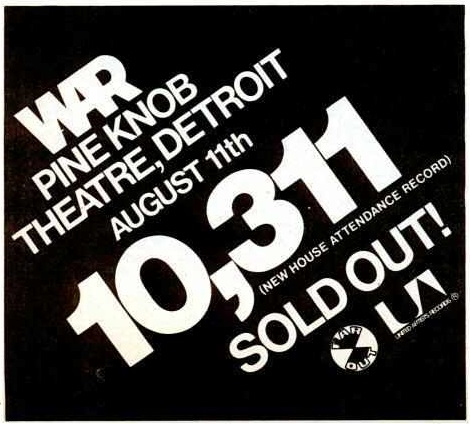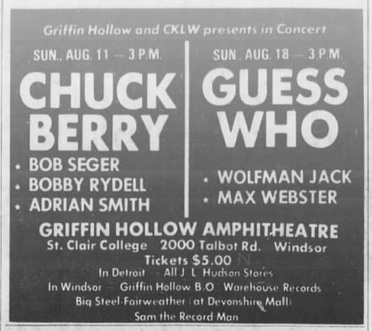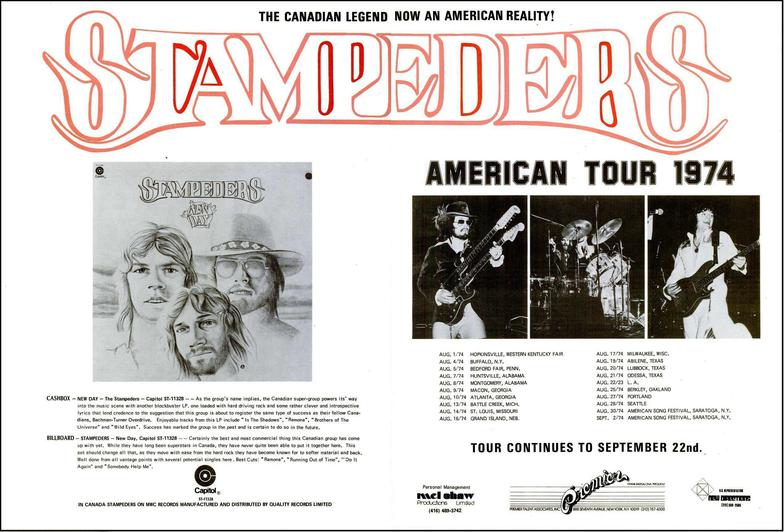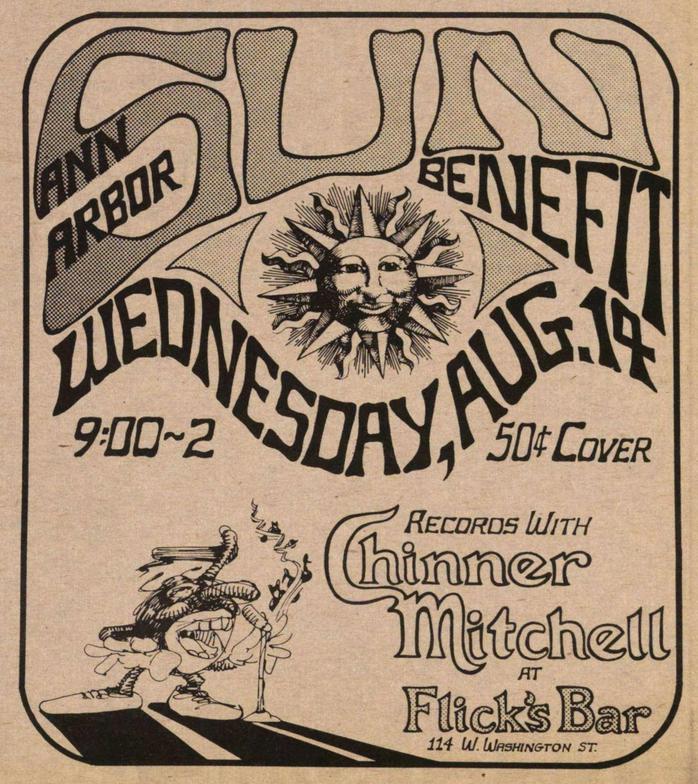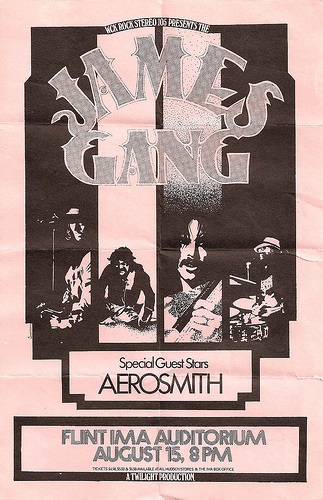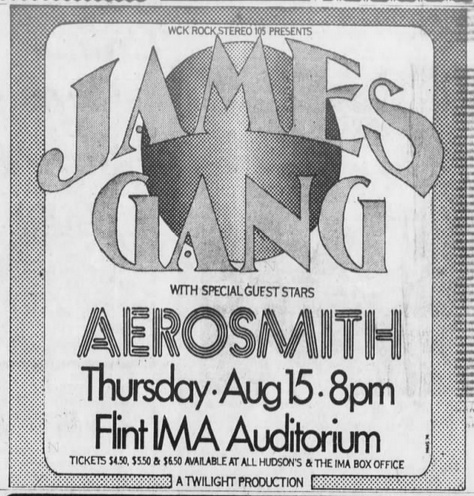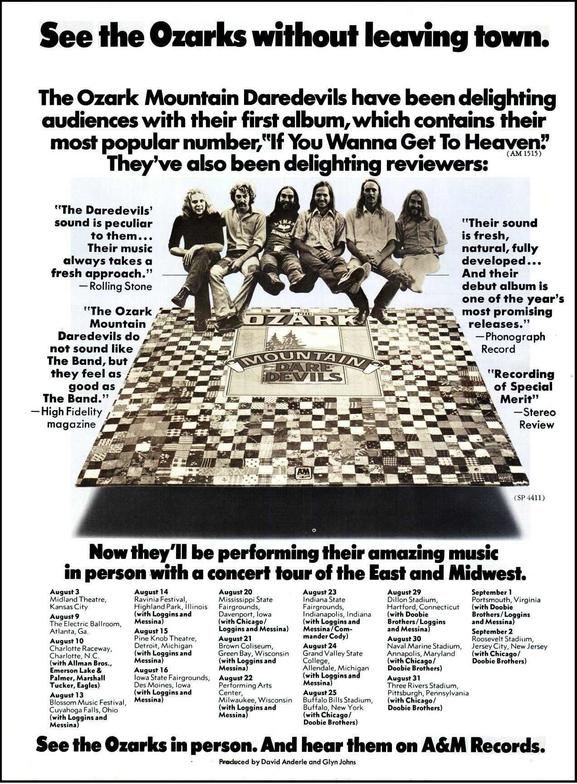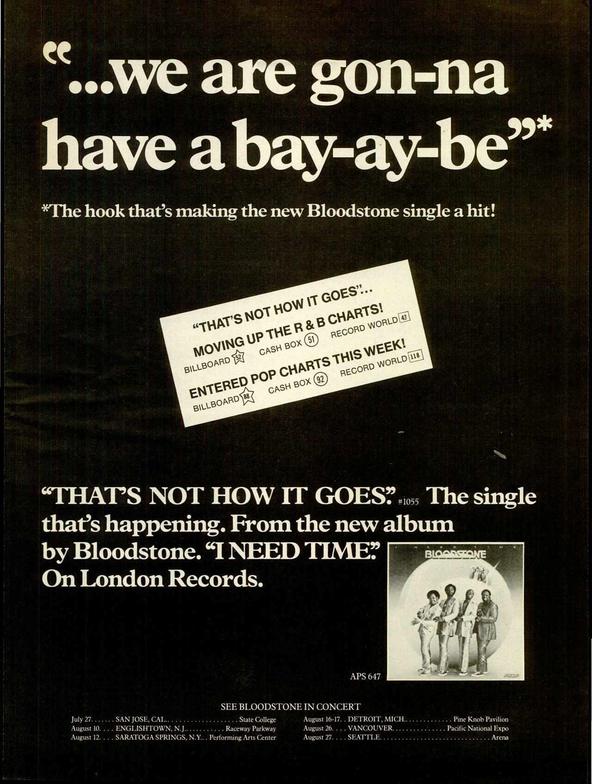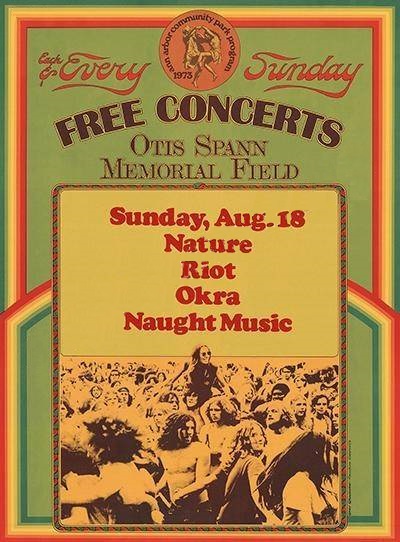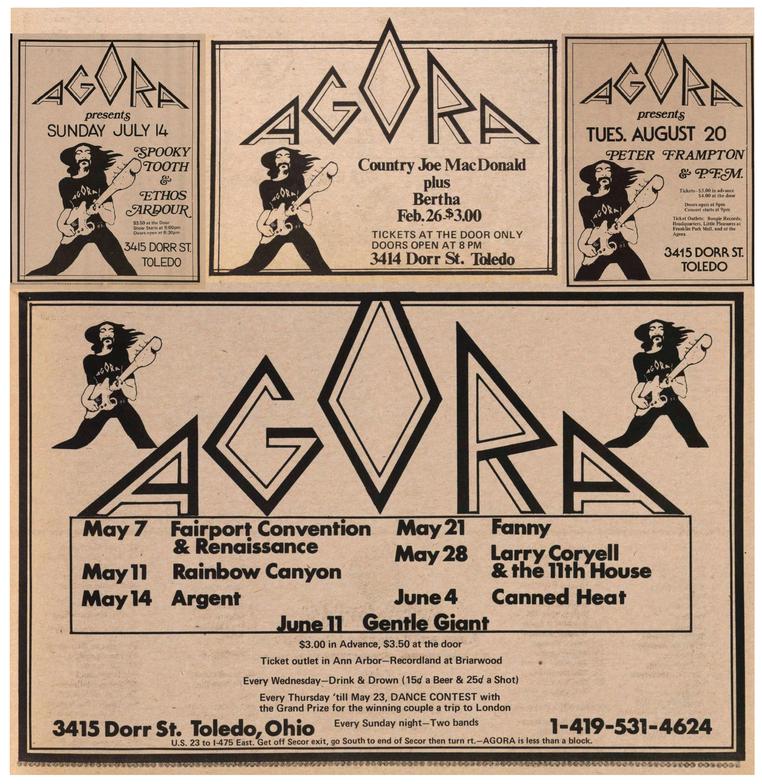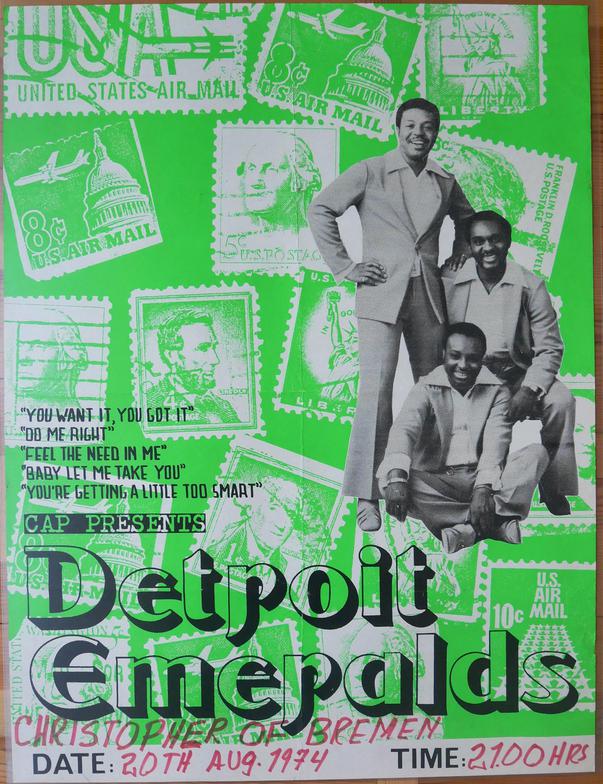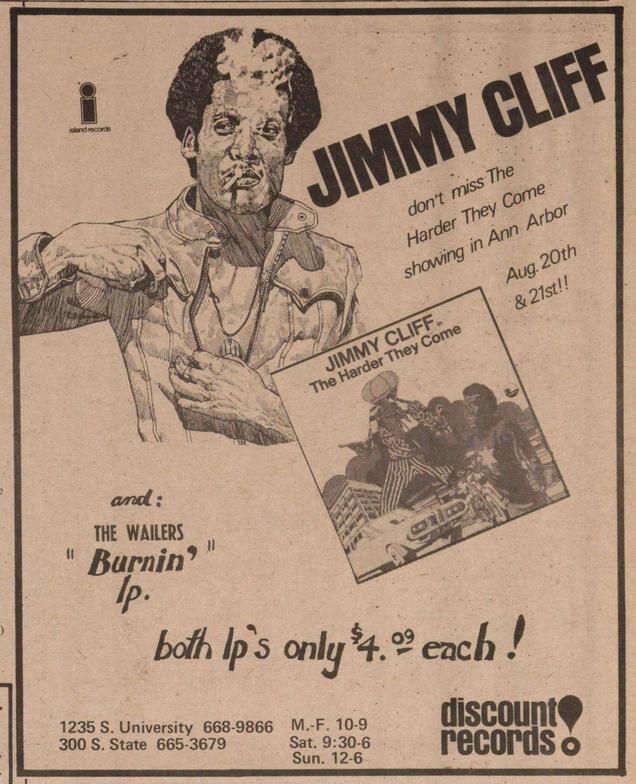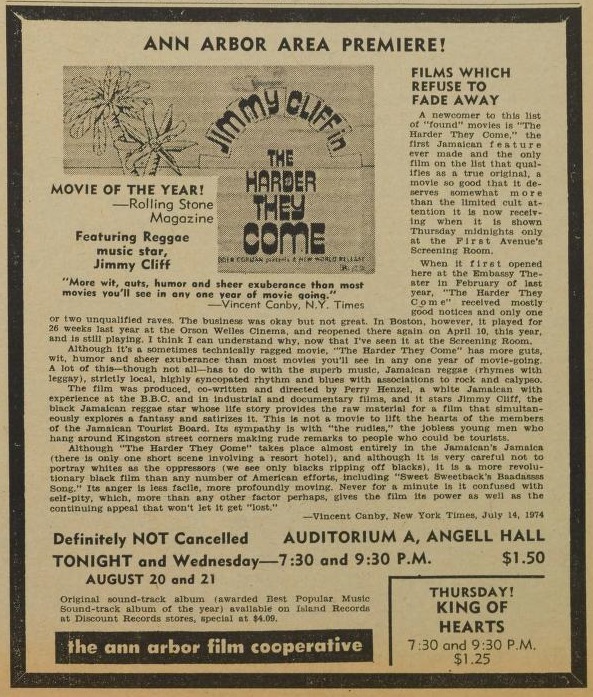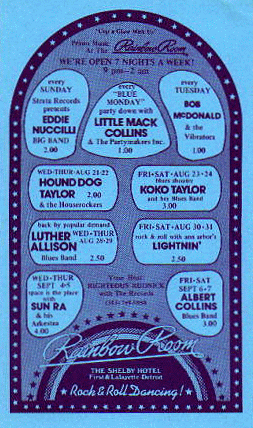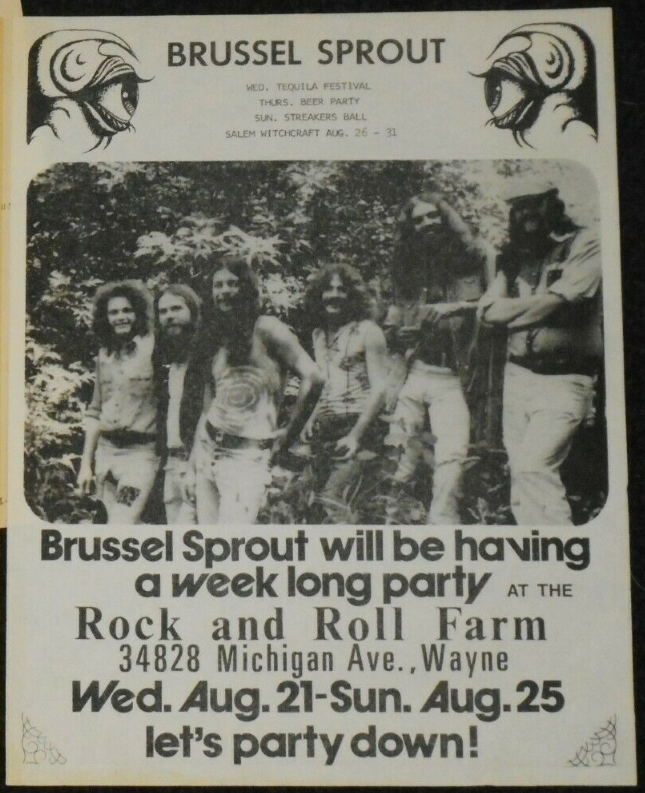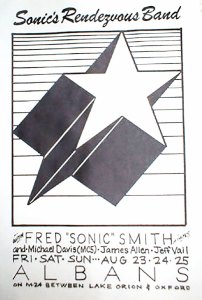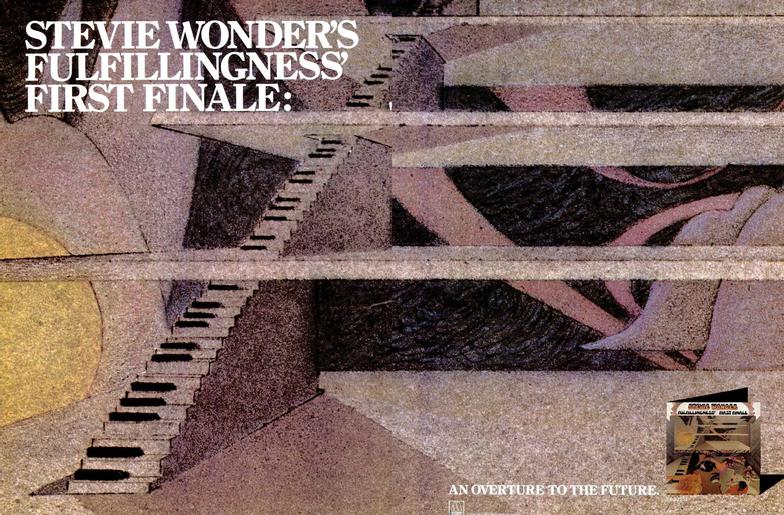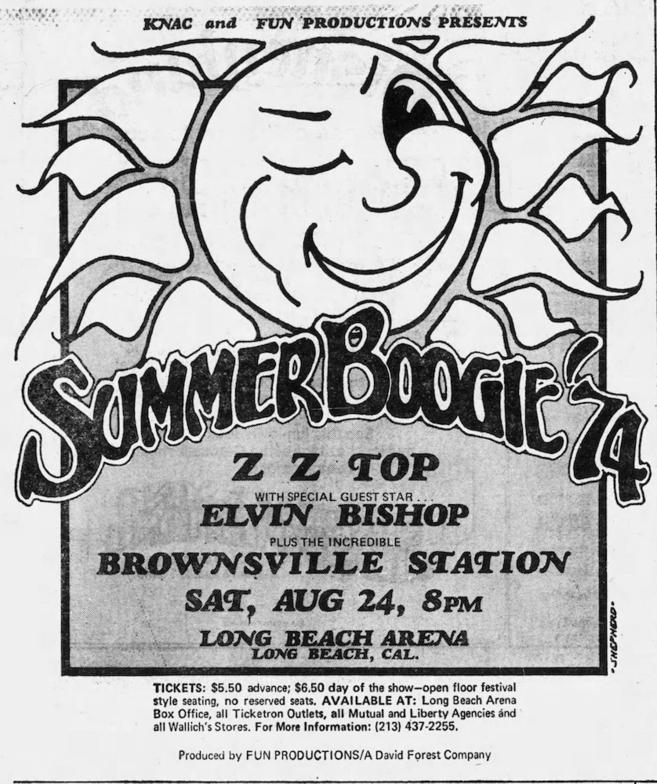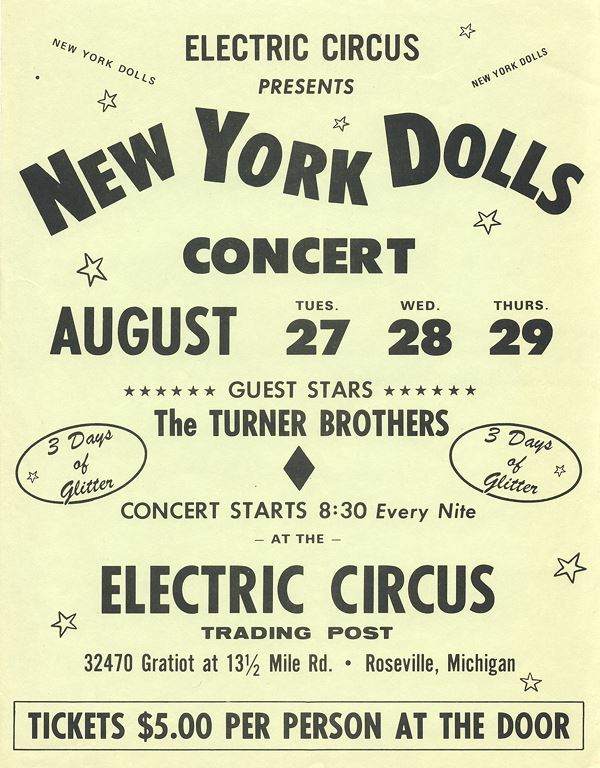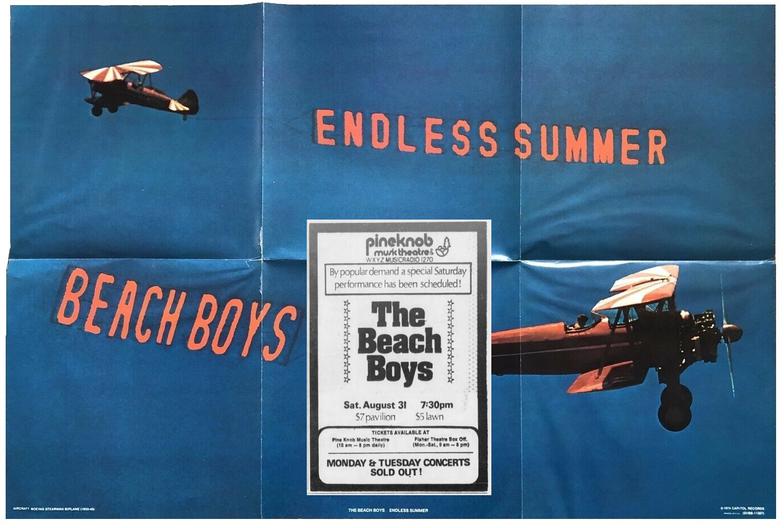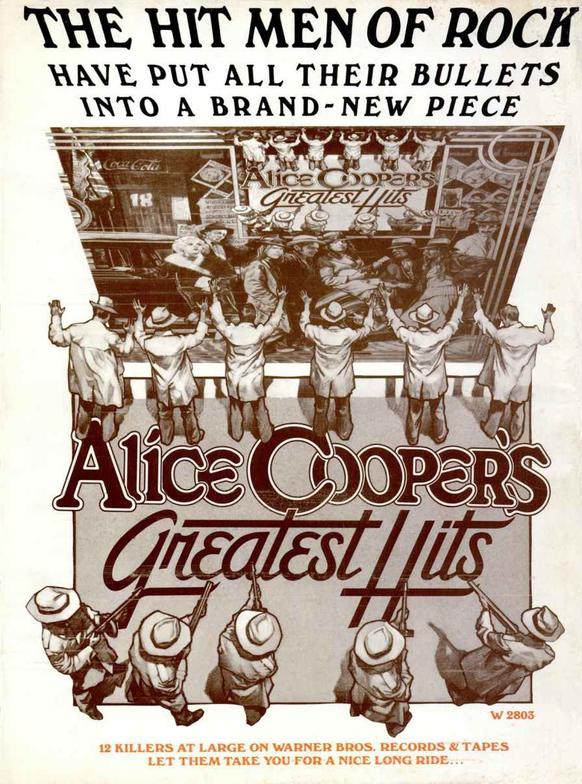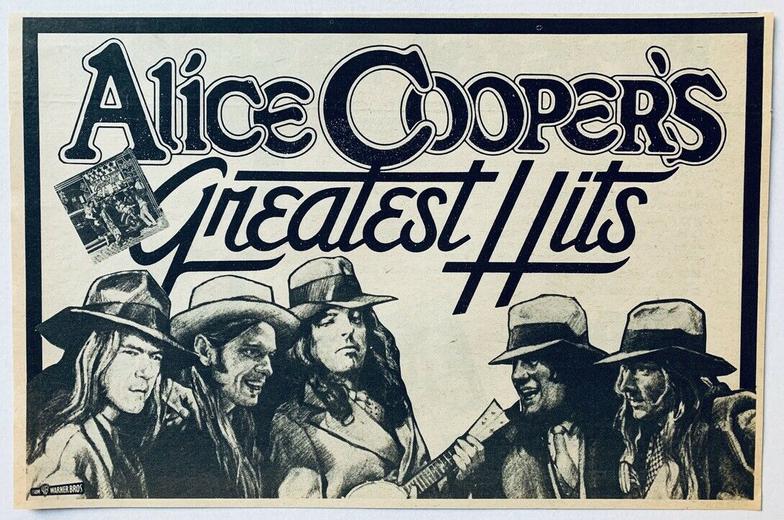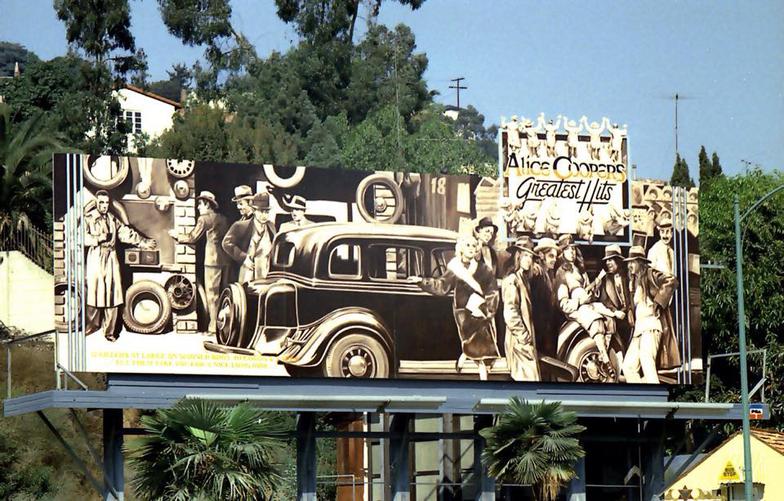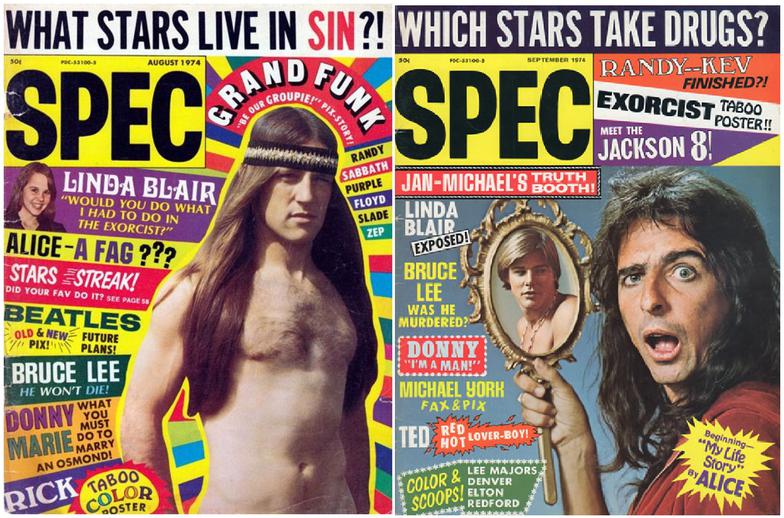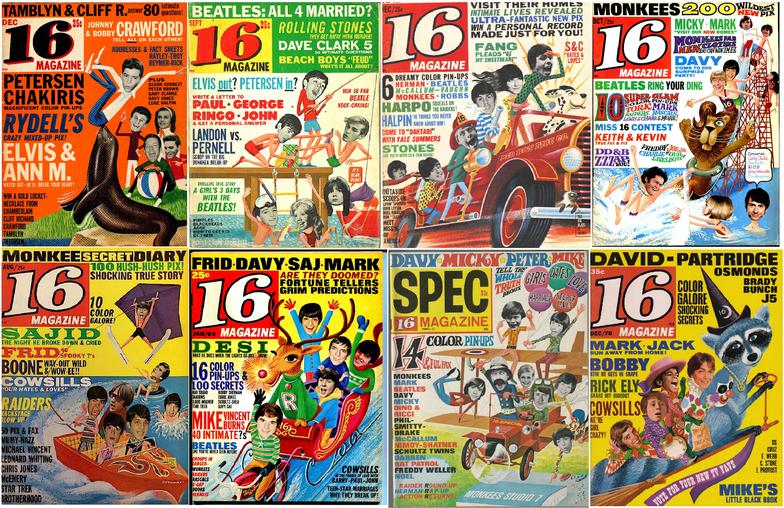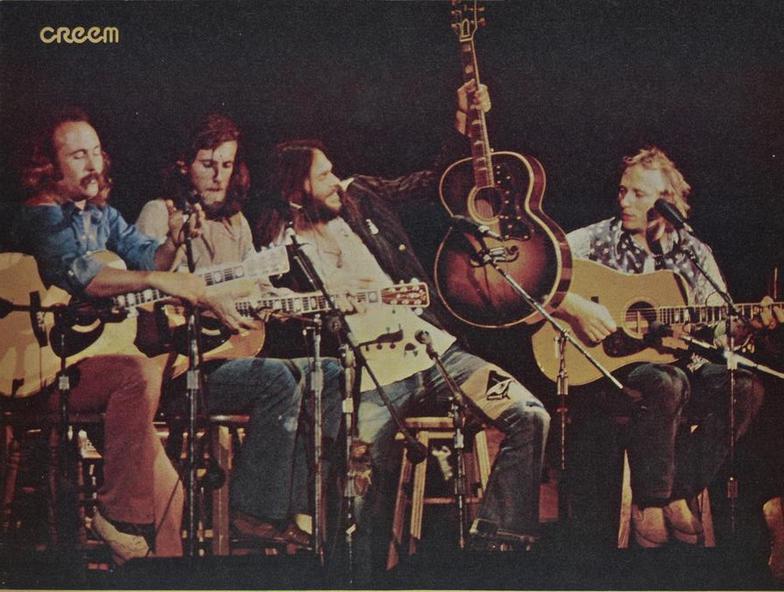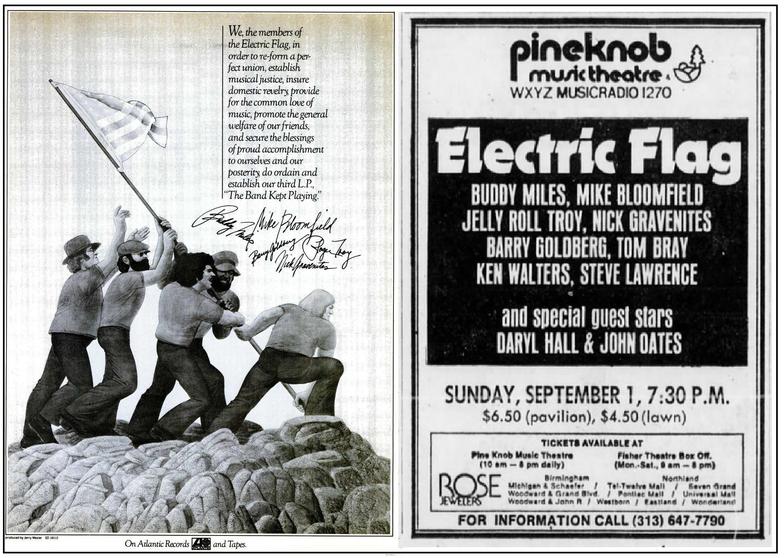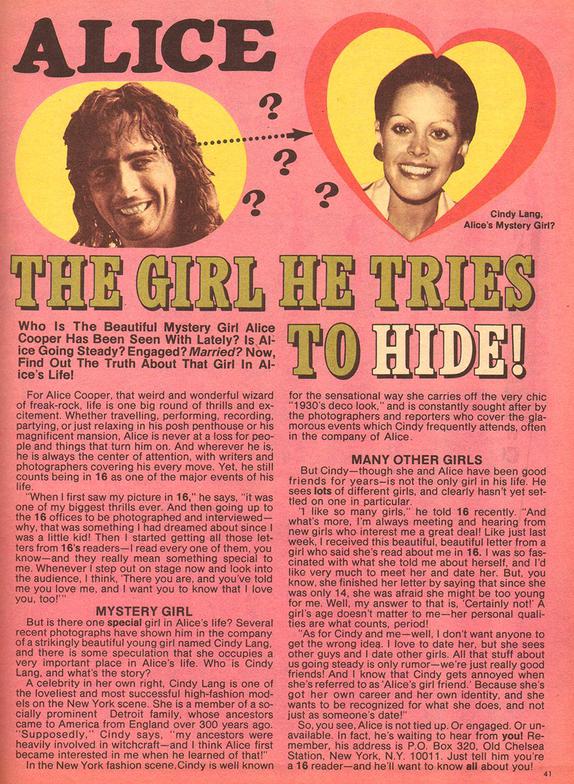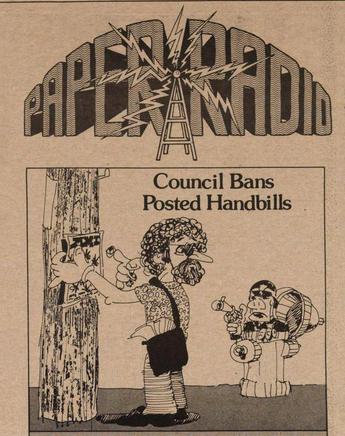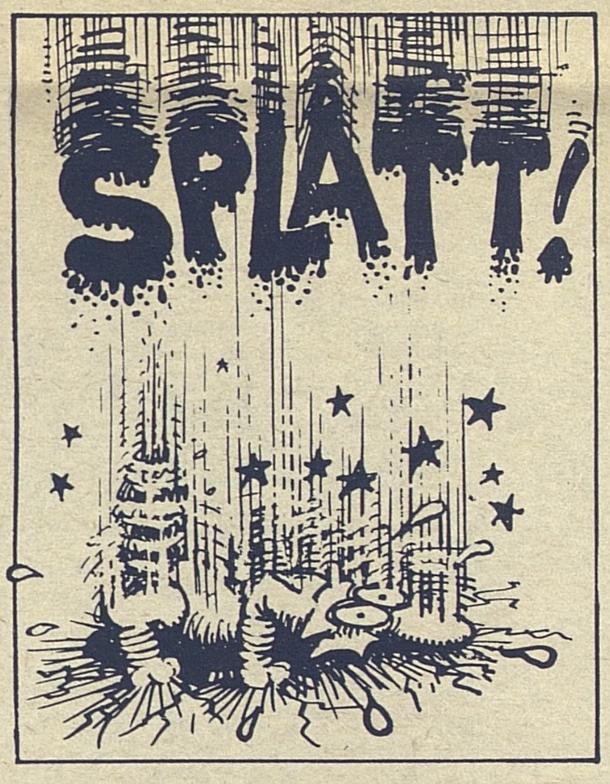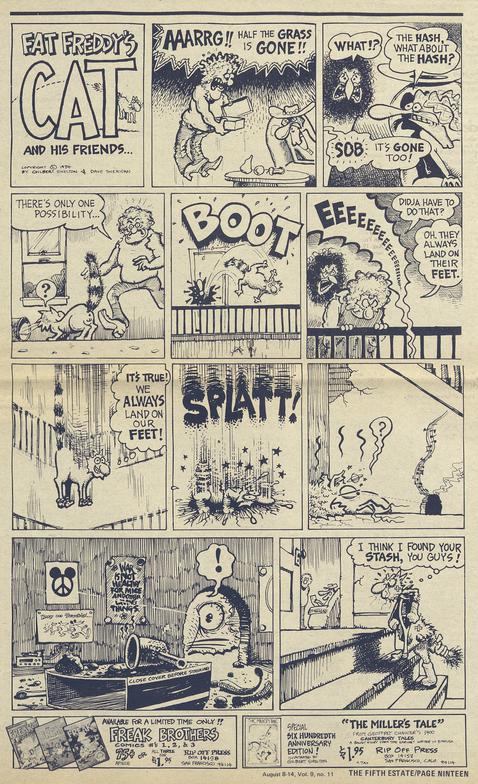Splatt Gallery
Double click here to add text.
Splatt Gallery's History of Michigan Music Posters
Volume Ten - 1974 - Page Thirteen
***********************************************************
Newspaper ad for Joni Mitchell at the Pine Knob Music Theatre in Clarkston, Michigan on August 8, 1974. A second date was added for the following night as well.
Joni Mitchell’s 1974 tour resulted in her first live album, a two-record set called “Miles of Aisles”. There were four Michigan shows over the course of the tour, and although none of the album tracks came from any of those shows, the album cover was a photo, taken by Mitchell, at the Pine Knob Music Theatre in Clarkston, Michigan.
The August 9, 1974 edition of the Ann Arbor SUN newspaper saw the return of writer Freddie Brooks to the “Michigan Boogie” column, providing updates on the local bands, especially in their recordings activities.
Bob Seger had wrapped up what would become his eighth album, his Silver Bullet Band had added keyboardist Robyn Robins, played well-received shows in California and was currently on a tour of the Northwest supporting Bachman-Turner Overdrive.
Sky King, former members of the band New Heavenly Blue with the addition of second guitarist Rick Jacobi, had enlisted a new lead vocalist and were in Memphis working on their first album.
Uprising had two recorded songs in the can, but bassist Gary Rasmussen had left the group and a new band name was under consideration. The band Lightnin’ had two album’s worth of material recorded but were without a label.
Lightnin’ had two albums of material “in the can” with plans to release a single in the fall, with an album in the winter. They had upcoming shows at the Red Carpet in Detroit for August 19, 20, 26 and 27, and at the Rainbow Room in Detroit, August 30-31.
The Rockets were anticipating the release of an original single, as were Kramer’s Kreamers, also touted as Wayne Kramer & the new MC5, whose drummer Melvin Davis was also working on a solo album with the Philadelphia Soul producers Gamble & Huff.
And lastly, the single by Scott Morgan was getting some FM radio play and it was rumored that ex-Stooges drummer Scott Asheton might be joining his group. The Scott Morgan single was re-issued in 2000 with a nice picture sleeve and finally, after twenty-six years, a listing of all the musicians involved in the recording.
Scott Morgan – Take A Look (1973)
https://www.youtube.com/watch?v=k0n87uKoDeU
Scott Morgan – Soul Mover (1973)
https://www.youtube.com/watch?v=hOnFyAPrjY0
A poster by an unknown artist for a “Barn Dance” featuring Bob Seger, the Rockets, Rabbits and the Martian Entropy Band in Ypsilanti Township, Michigan on August 9, 1974. You may notice that there is no specific location noted on the poster, presumably you had to be “in the know” for this party, at the somewhat infamous “Animal Farm”, although the tickets (seen in the comments below) had an address on Textile Road.
A detailed account of the event is found in David Bardallis’ 2013 book “Ann Arbor Beer – A Hoppy History of Tree Town Brewing”, excepted below:
“Iggy Pop is not the only famous Ann Arbor musician to request beer for his performances. Just before his 1975 album “Beautiful Loser” launched his career into the stratosphere, all Bob Seger wanted from one concert promoter was a six-pack of Heineken for his tour bus. Unfortunately for Seger, there was no beer to be found at the rustic outdoor venue. It had all just been dumped into a nearby lake during a police raid.
“That concert promoter, Robert Jr. Whitall, remembered the event very well. ‘It took place on August 9, 1974, the day Richard Nixon resigned,’ he said. Today, Whitall runs ‘Big City Rhythm & Blues’ magazine from Royal Oak, but he was ‘just a poor college kid’ when he and his late friend Steve Post had the idea to throw a ‘big barn dance party’ on the Ypsilanti Township farm where Post lived. The farm, adjoining Ford Lake, was being sold, and a party seemed like a good way to say goodbye to the property. But it was to be no ordinary party.
“’I used to golf with Bob Seger’s manager, Punch Andrews,’ recalled Whitall. ‘Bob agreed to come play at our barn party, and it turned out o be his last gig before he hit the big time.’
“Whitall and Post lined up three other bands – the Rabbits, the Martian Entropy Band and the Rockets – and printed up flyers to distribute around Ann Arbor and Ypsilanti advertising their ‘Barn Dance for All the Animals’. ‘Five dollars a head, all the beer you could drink, and Bob Seger: what’s not to like?’ Mike Gould of the Martian Entropy Band remembered in a 2007 ‘Ann Arbor Observer’ article.
“The barn, being a barn, had no power, so Whitall’s crew ran a cable out to illegally tap an electrical box on the side of Textile Road. They bought forty kegs of beer – Whitall believes it was Molson Canadian – and forty cases of wine and set it all up in a picnic area on top of a hill. Whitall’s fiancé collected the five-dollar ‘donations’ from cars as they drove up the dirt road, though as Whitall recalled, most of the ‘immense crowd’ parked across a field and just walked in for free.
“The first two bands went on, then Seger took the stage and everything seemed to be going well, at least until Whitall looked out of the window of the farmhouse where he was sitting and saw cops coming up the road. Someone had reported the party to the state police and the Liquor Control Commission to boot.
“’We didn’t have a liquor license, but that’s why we asked for ‘donations,’ recalled Whitall. ‘We weren’t selling beer, and our lawyer had said that would be fine.’ The cops would have none of it, so Whitall made a decision. ‘I sent a runner up the hill and told him to throw the kegs in the lake,’ he said. ‘If we couldn’t have them, the cops weren’t going to get them either.’
“Gould remembered being in the barn loft helping put on the light show behind Seger when he looked out and saw people rolling kegs of beer down the hill and into Ford Lake with a splash. Steve Post and Whitall’s lawyer were hauled off by the cops, but the party continued, beer-free.
“Shortly after, Seger’s set was over, and he asked for his Heineken. ‘I had to scramble to find someone who could go get him the beer so we could satisfy his rider,’ remembered Whitall. ‘But he stuck around for the Rockets, and it was great seeing him dancing in the barn – it was such a low-key and wonderful event.’
“Local legend has long held that the kegs of beer are still lying somewhere at the bottom of the lake, but Whitall said that the police came back later with a dive team to retrieve them. And a court eventually ruled that the cops had no right to bust the barn dance in the first place, but as Whitall wryly noted, ‘That ruling didn’t do us any good 10 years later.’”
Now, if that cool story is not enough for this post, we also have more treats here for you. It turns out that the Martian Entropy Band is still, somewhat, around, and they can be found here:
https://www.hughjhitchcock.com/martianentropyband/
And another track by the band is found here:
The Martian Entropy Band – Pandemonium Ballet Part 1 (1973)
https://www.youtube.com/watch?v=WQ_pq7WlZyc
The ticket for the “Barn Dance” at the “Animal Farm”, with the Textile Road address.
Business card by an unknown artist for the Light Opera Light Show, which was associated with the Martian Entropy Band from Ann Arbor, Michigan.
An unusual poster for ZZ Top, with special guests Brownsville Station and Dr. John in Seattle, Washington on August 9, 1974.
A Discount Records ad by Jive Comix, aka Ted Echterling, in the August 9, 1974 edition of the State News in East Lansing, Michigan.
An ad for Hank Williams Jr. with tour dates that include three Michigan shows, at the Cass County Fair in Cassopolis on August 9, 1974, at the Upper Peninsula State Fair in Escanaba on the 15th, and at the Calhoun County Fair in Marshall on the 23rd.
An ad by an unknown artist for the Underground in Ypsilanti, Michigan with the line-up from August 9, 1974 through the end of the month, featuring the bands Iris, Riley, Theater and Crosswind.
Poster by Train Printing Company with Brownsville Station and DR. John opening for ZZ Top in Portland, Oregon on August 10, 1974.
An odd Motown Records ad in the August 10, 1974 issue of Billboard magazine, with no new record to sell, but a subtle announcement of a major shake-up in the ranks of the band Rare Earth.
They had started the year at, possibly, the peak of their Version 2.0 power, as the opening act at the influential California Jam festival in April, but apparently things fell apart in the studio during the recording of their follow up to the album “Ma”. Drummer and lead vocalist Peter Hoorelbeke left the band, leaving saxophonist Gil Bridges as the only remaining member from the original line-up. Mark Urso, who had replaced original member bassist John Persh when the band moved to Los Angeles in 1972, left with Hoorelbeke. Keyboardist Mark Olson also decided to join Jennifer Warnes’ band, leaving Bridges, percussionist Eddie Guzman and guitarist Ray Monette to recruit a new group.
Drummer Barry Frost, formerly with Lee Michaels and the band Sweathog, bassist Reggie McBride, formerly with Stevie Wonder’s band, and Jerry LaCroix, vocalist and sax player with Edgar Winter’s White Trash and Blood, Sweat & Tears joined up and are have their photographs on the ad (we added the name labels and hope we got them right). Not shown, but also soon to join for the recording of the next album, are keyboardist Gabriel Katona and guitarist Paul Warren.
A full-page Motown Records ad in the August 10, 1974 issue of Billboard magazine, pitching the new albums from Stevie Wonder, the Commodores, and the Undisputed Truth, and anthology sets from the Four Tops and Jr. Walker & the All Stars.
August 11, 1974 is a legendary night in Iggy Pop lore, for the one-off performance of the “Death of/Murder of a Virgin” at Rodney Bingenheimer’s English Disco in Los Angeles, California. This is the show where the color photos of a bloody Iggy with Ron Asheton in a Nazi uniform come from, there are also many black-and-white photos from the night.
Apparently, it began nearly spur of the moment when Iggy showed up at the LA apartment of bassist Nigel Harrison, of the band Silverhead, with a song idea in his head that required a simple “drone in F sharp” bass line. Satisfied with Harrison’s part, Iggy told him to show up that night at the English Disco and dashed off to “find a guitarist, a drummer, and a virgin”.
The “virgin” ended up being a boy that Iggy found at the Denny’s restaurant down the street from the club, there ended up being no guitar player (as confirmed by Ron Asheton), and the drummer, in spite of Harrison’s recollection, was certainly not the drummer from the space-pixies band Zolar X.
Zolar X – Energize Me (1974)
https://www.youtube.com/watch?v=ZPxImjOeloY
Dennis Preston’s poster from April 1973 is re-purposed for this show by Northwind and Still Eyes in Roseville, Michigan on August 11, 1974, with the added attractions of Toby Redd and Steve White & Slaughter House.
According to this ad, the band WAR set a new house attendance record at the Pine Knob Music Theatre in Clarkston, Michigan on August 11, 1974.
An ad for Bob Seger with Chuck Berry, Bobby Rydell and Adrian Smith at the Griffin Hollow Amphitheatre in Windsor, Ontario, Canada on August 11, 1974. This would be the same location for the Ann Arbor Blues & Jazz In Exile in just over three weeks away.
An article in the September 5th edition of The Windsor Star Newspaper was foretelling the financial disaster soon to come for Rainbow Productions:
“Tickets just aren't selling for Griffin Hollow concert. The Ann Arbor Blues and Jazz Festival is facing its most dangerous opponent in a long list of adversaries indifference. Tickets just aren't selling. At least, not so far. And the three-day festival starts tomorrow. "A couple of thousand" series tickets had been sold by Tuesday of this week, according to the estimate of Darlene Pond, press spokesman for Rainbow Multi-Media, the festival backers. "We're getting ready to sell at the door," she said morosely. "We didn't want to, but we'll have to."
“Why haven't the Ann Arbor college students who supported the four previous festivals, sometimes up to 20,000 strong, eagerly joined the festival's exile? "People are afraid of the border. They want to go to a festival and get high," she said bluntly of the music-lovers.
“Detroit advertising has been underlining the dangers of transporting the means for getting high across that border. Legal Assistance of Windsor, the clinic sponsored by the University of Windsor Law School, has volunteered to keep its downtown office open extra hours on the weekend but it can only offer advice over, the phone. (While the Rainbow ads have been straight about some things, they win another "Truth in Advertising" award from your old pop for that radio blurb saying camping is available but conveniently neglecting to mention that tenters will be evicted from the St. Clair campus and pointed towards provincial or private campsites away from the college.)
“Rainbow hopes to sell half the 12,000 capacity at Griffin Hollow with Canadians, yet ticket sales here have been very slow. For their sake, I hope the weekend dawns clear and warm, or it may be the organizers who are crying the ' blues.”
A two-page spread in Billboard magazine for the Canadian group Stampeders, with tour dates including a show in Battle Creek, Michigan on August 13, 1974.
An ad by Chris Frayne (Ozone) for the second of two benefit shows for the Ann Arbor SUN newspaper at Flick’s Bar in Ann Arbor, Michigan on August 14, 1974.
A poster which we believe is by Hugh Surratt for the James Gang with Aerosmith in Flint, Michigan on August 15, 1974. This was Aerosmith’s 13th Michigan show of the year as their train kept a’rolling in their record year.
An ad which we believe is by Hugh Surratt for the James Gang with Aerosmith in Flint, Michigan on August 15, 1974.
A full-page A&M Records ad for the Ozark Mountain Daredevils with tour dates that include two Michigan shows, one at the Pine Knob Music Theatre in Clarkston on August 15, 1974, and one at the Grand Valley State College in Allendale on the 24th, both shows in support of Loggins & Messina. As we’ve seen, GVSC had great posters for their shows, but we haven’t found this one yet.
A couple of months after these shows, the Ozark Mountain Daredevils released their second album, which included the track “Jackie Blue”, later released as a single that reached #3 on the Billboard Hot 100 chart and #1 for two weeks on the Cashbox Singles Chart.
Ozark Mountain Daredevils – Jackie Blue (1974)
https://www.youtube.com/watch?v=Qr0hcoksupQ
A full-page London Records ad for the band Bloodstone with tour dates that include two Michigan shows, at the Pine Knob Music Theatre in Clarkston (close enough to Detroit for a national readership) on August 16-17, 1974.
Gary Grimshaw poster blank with the acts for the Sunday Free Concert in Ann Arbor, Michigan on August 18, 1974; Nature, Riot, Okra, and Naught Music.
A collection of ads from the Agora in Toledo, Ohio in the summer of 1974 that use Gary Grimshaw’s guitarist illustration from the Goose Lake Festival program back in August 1970. The image on the guitarist’s shirt has been changed from the original pot leaf to the Agora logo.
A very nice poster for a show by the Detroit Emeralds somewhere in Germany(?) on August 20, 1974. It lists the group’s most recent single “You’re Getting a Little Too Smart”, the album version, linked below has the opening drum break that has been sampled by Kendrick Lamar, Common, LL Cool J, MF Doom, Limp Bizkit, Slum Village, Main Source, Raekwon, and on and on and on.
The Detroit Emeralds – You’re Getting a Little Too Smart (1973)
https://www.youtube.com/watch?v=556zH4MuPL8
After wearing out the grooves of the soundtrack album for two years, we finally got to see the movie when “The Harder They Come” had its Ann Arbor premier on August 20-21, 1974.
The Harder They Come – (movie) (1972)
https://www.youtube.com/watch?v=j9U1zc8ys-Q
Poster with J.W. Kelly’s logo for the Rainbow Room in the Shelby Hotel in Detroit, Michigan, with the scheduled acts from August 21, 1974 through the first week of September, including Hound Dog Taylor, Koko Taylor, Luther Allison, Lightnin’, Sun Ra and Albert Collins, with regular weekly appearances by Eddie Nuccilli Big Band, Little Mack Collins & the Partymakers Inc and Bob McDonald & the Vibrators, all hosted by Righteous Rudnick with The Records.
A poster by an unknown artist for the band Brussel Sprout at the Rock and Roll Farm in Wayne, Michigan, August 21-25, 1974. Here is some home video by the band, shot in Monroe, Michigan:
https://www.youtube.com/watch?v=pTgaKiL1mcA
The earliest poster/flyer that we’ve found for Sonic’s Rendezvous Band was for a show at Alban’s in Lake Orion, Michigan, August 23-25, 1974. The band line-up was Fred “Sonic” Smith and Michael Davis, both ex-MC5, with James Allen and Jeff Vail. The Fifth Estate newspaper described the venue, also known as Alban’s Country Cousin, as “High powered rock music in the boondocks, and boy the people jump around in here”.
This one is such a bit of an outlier that it warrants a closer examination, and we do find somewhat supporting evidence in Michael Davis’ autobiography “I Brought Down The MC5”. He devotes only three pages from the MC5’s final appearance on New Years’ Eve 1972 to the “bright, crispy cold day in January 1975” when he was arrested at his home by DEA agents. The years of 1973 and 1974 are given only a few words, but here are the passages regarding Davis’ musical activities for those years:
“Fred Smith had kept in touch with me. We had managed to stay friends despite the falling out I had with the group. He had a notion that I might be better equipped to sing than play bass guitar, and I had those thoughts myself.
“We decided to form a group with a different bass player, Dennis (Thompson) as the drummer, and me singing lead and hammering on a small Casio keyboard. I think we placed an ad for a bass player, which was answered by a fellow named John Hefti, whom we hired without trying anyone else. We played mainly cover tunes. After a couple weeks of practice, we got booked to play the bowling alley bar in Lincoln Park.”
After describing damaging his vocal chords attempting to sing three sets a night, Davis writes:
“I was losing confidence and I was very afraid of disappointing Fred. We got together with another guy named James Allen (one of the names on the above flyer), who was an accomplished keyboardist. He was a nephew of the famous union leader Jimmy Hoffa.
“We called our new band Ascension, after the John Coltrane album. It was pretty much organized by Fred, and mainly featured Fred’s latest originals.
“We played a couple of gigs locally, but we didn’t ever gel as we had hoped. After a line-up change or two, Fred came up with the name Sonic Rendezvous. I played at least one live show as Sonic Rendezvous, trying to sing Fred’s songs and play keyboard, but I didn’t have what it took at all. I think we both decided to let it go. Of course, a couple of years later, Fred put together Sonic’s Rendezvous Band with Scott Morgan, Scott Asheton, and Gary Rasmussen, to considerable acclaim in the Detroit/Ann Arbor area (and in years to come, the rest of the world).”
Back to the above flyer, the name of James Allen is confirmed, we might conclude that Jeff Vail is the drummer, and Michael Davis did perform as part of a band named Sonic’s Rendezvous.
Artwork by Bob Gleason from the inside of the gatefold album cover of Stevie Wonder’s Fullfillingness First Finale used for an ad in the August 24, 1974 issue of Billboard magazine.
Poster/ad by Roger Shepherd for the “Summer Boogie ‘74” in Long Beach, California on August 24, 1974 with Brownsville Station.
A very nice all-text poster, by an unknown artist, for the New York Dolls with the Turner Brothers at the Electric Circus, inside the Trading Post mall in Roseville, Michigan, for three shows, August 27-29, 1974, a return to the same venue that they had played back in May. With these shows the Dolls had performed ten shows in Michigan, all within the space of a year. It would be another two years before they would return again.
A poster that came with the double album set “Endless Summer” by the Beach Boys, released in June 1974. The group’s old label Capitol Records compiled the greatest hits collection following the success of the film “American Graffiti” and a wave of nostalgia for the oldies. The album spent 155 weeks on the Billboard albums chart, sold over three million copies and became their second #1 album, ten years since their first.
It also revitalized the band's popularity as a live act, as they sold out three nights at the Pine Knob Music Theater in Clarkston, Michigan, August 31, 1974 through September 3rd.
The Beach Boys - All Summer Long (1964)
https://www.youtube.com/watch?v=2tytTebj8ic
A full-page ad in the August 31, 1974 issue of Billboard magazine for “Alice Cooper’s Greatest Hits” album, artwork by illustrator Drew Struzan with art direction by Ernie Cefalu of Pacific Eye & Ear.
An ad for “Alice Cooper’s Greatest Hits” album, with artwork by illustrator Drew Struzan. Released in August 1974, the album reached #8 on the Billboard 200 albums chart.
Alice Cooper’s Greatest Hits album, released in August 1974, gets the full billboard treatment in Los Angeles, California.
It took too long for only the third Michigan pop star to grace the cover of 16 Magazine, by the time that Mark Farner appeared as a cover star on the August 1974 issue, the magazine had dropped their long-standing cover format of photographed heads with cartoon bodies in wacky and fun situations.
The September 1974 issue had Alice Cooper on the cover for his 13th time, eleven of those had been with a cartoon body.
Incidentally, SPEC was a 16 Magazine companion, the first one’s were called 16 Spectacular, and were originally issued twice a year, starting in 1964, but eventually the shortened SPEC was nearly a monthly along with the regular 16 Magazine. In addition, there were various special issues, such as the July 1973 Holiday Special, which we posted previously, the “Freak Rock” Special that had Alice, looking rather more like Marilyn Manson, on the cover
The cartoon-body cover format had started with the October 1961 issue and ran non-interrupted until the May 1974 issue. We’ll put a few together to show you what we mean, because from here out, 16 Magazine is dead to us.
Here is an assortment of covers from 16 Magazine to make the point about the cartoon-body celebrities that can only inadequately be described in words. The work of Editor-In-Chief Gloria Stavers and illustrator Fred Chance was quite remarkable in finding the perfect head shot to fit the bodies and the scene.
These lively compositions were unique to 16 Magazine, at least in terms of longevity, running for thirteen years, from 1961 into 1974.
The head photos were black-and-white up until the October 1967 issue, the water slide scene shown above in the upper right corner. The all white boys ethnic barrier was broken with the February 1968 issue with the appearance of actor Sajid Khan, along with his castmate Jay North (yes, the Dennis the Menace actor) from the “Maya” TV show. North appeared only on that single issue, but Sajid was on nearly every cover for the entire year of 1968, often pitted against the Monkees in some contrived war, he is driving the boat on the issue in the lower left corner.
Clarence Williams III of “The Mod Squad” became the first black person to make the cover, with a one-off appearance on the February 1969 issue. Michael Jackson made his first appearance on the December 1970 issue, seen above on the lower right.
Occasionally, an odd choice such as Jonathan Frid from the “Dark Shadows” TV show would pop up, he can be seen above on the sledding cover from the January 1969 issue. Alice Cooper might have been considered an odd choice, except for the fact that he appeared on at least thirteen issues, right alongside Donny and David, Bobby and Rick, the readers of 16 Magazine were always on a first-name basis with their idols.
CREEM magazine had been running the occasional full-color photo pages since the December 1972 issue, they finally got the idea to add their name to the photos, creating a CREEM mini-poster, starting with this shot of Crosby, Stills, Nash & Young in the September 1974 issue. Photo by Neal Preston.
The Electric Flag had a brief reunion in 1974, six years after their breakup in 1968. The band released a new album and performed a few shows, including one at the Pine Knob Music Theatre in Clarkston, Michigan on September 1, 1974, before calling it quits again. This was also the first Michigan appearance by the opening group Hall & Oates.
Volume Ten - 1974 - continues - HERE
Ever since the July 1973 special issue of 16 Magazine devoted to “Freak Rock”, Alice Cooper became an unlikely fixture on the covers of nearly every subsequent issue, where all the stars were on a first-name basis and every (teenage female) reader had a shot at a date (or more!) with all of them.
The following text is the one-page story that was contained within the January 1974 issue of 16 Magazine, titled "Alice - Meet the Girl He Hides":
“For Alice Copper, that weird and wonderful wizard of freak-rock, life is one big round of thrills and excitement. Whether traveling, performing, recording, partying, or just relaxing in his posh penthouse or his magnificent mansion, Alice is never at a loss for people and things that turn him on. And wherever he is, he is always the center of attention, with writers and photographers covering his every move. Yet, he still counts being in 16 as one of the major events of his life.
“’When I first saw my picture in 16,’ he says, ‘it was one of my biggest thrills ever. And then going up to the 16 offices to be photographed and interviewed – why, that was something I had dreamed about since I was a little kid! Then I started getting all those letters from 16’s readers – I read every one of them, you know – and they really mean something special to me. Whenever I step out on the stage now and look into the audience, I think, ‘There you are, and you’ve told me you love me, and I want you to know that I love you, too.’
“But is there one special girl in Alice’s life? Several recent photographs have shown him in the company of a strikingly beautiful young girl named Cindy Lang, and there is some speculation that she occupies a very important in Alice’s life. Who is Cindy Lang, and what’s the story?
“A celebrity in her own right, Cindy Lang is one of the loveliest and most successful high-fashion models on the New York scene. She is a member of a socially prominent Detroit family, whose ancestors came to America from England over 300 years ago. ‘Supposedly,’ Cindy says, ‘my ancestors were heavily involved in witchcraft – and I think Alice first became interested in me when he learned of that!’
“In the New York fashion scene, Cindy is well known for the sensational way she carries off the very chic ‘1930’s deco look’, and is constantly sought after by the photographers and reporters who cover the glamorous events which Cindy frequently attends, often in the company of Alice.
“But Cindy – though she and Alice have been good friends for years – is not the only girl in his life. He sees LOTS of different girls, and clearly hasn’t yet settled on one in particular.
“’I like so many girls,’ he told 16 recently. ‘And what’s more, I’m always meeting and hearing from new girls who interest me a great deal! Like just last week, I received this beautiful, beautiful letter from a girl who said she’s read about me in 16. I was so fascinated with what she told me about herself, and I’d like very much to meet her and date her. But, you know, she finished her letter by saying that since she was only 14, she was afraid she might be too young for me. Well, my answer to that is, ‘Certainly not!’ A girl’s age doesn’t matter to me – her personal qualities are what counts, period!’
“’As for Cindy and me – well, I don’t want anyone to get the wrong idea. I love to date her, but she sees other guys and I date other girls. All that stuff about us going steady is only rumor – we’re just really good friends! And I know that Cindy gets annoyed when she’s referred to as ‘Alice’s girlfriend’. Because she’s got her own career and her own identity, and she wants to be recognized for what she does, and not just as someone’s date!’
“So, you see, Alice is not tied up. Or engaged. Or unavailable. In fact, he’s waiting to hear from YOU! Remember, his address is P.O. Box 320, Old Chelsea Station, New York, N.Y. 10011. Just tell him you’re a 16 reader – and he’ll want to know ALL about you!”
After killing the Ann Arbor Blues & Jazz Festival for 1974, and continuing a relentless series of actions, including profiting in moves contrary to the community’s wishes, exercising authoritarian rule in attempts to overrule the popular vote, transferring wealth intended for social programs into the pockets of their cronies, the Republican-controlled Ann Arbor City Council found yet, another way to show their contempt for the concept of community, and in a move dear to the hearts of poster artists, event organizers, and the fans and audiences, they implemented changes to the city’s handbill ordinance to make it illegal to post advertisements or circulars on any public structure, building or public way.
Apparently, they had failed in attempts over the issue in court, so they just re-wrote the law, and in addition to making it illegal to post handbills, they also further prohibited the “causing” of posting handbills, which made the advertiser and the producer liable to prosecution, meaning that they could go after the musicians, the promoters, the venue owners, the poster makers, the organizations and even political candidates. If your name was on the handbill, you were subject to a violation just as much as the poor schlub that was caught sticking it on a public trashcan.
The Ann Arbor SUN newspaper proposed the establishment of community billboards that could be used to provide a designated public space for posting communications, but, of course, the Council wasn’t interested in supporting that idea.
The cartoon that was published in the August 9, 1974 edition of the SUN looks like the work of Chris Frayne, aka Ozone.
The full-page comic of Gilbert Shelton’s “Fat Freddy’s Cat” in the August 8, 1974 edition of the Fifth Estate newspaper in Detroit, Michigan. And a particularly great panel.


